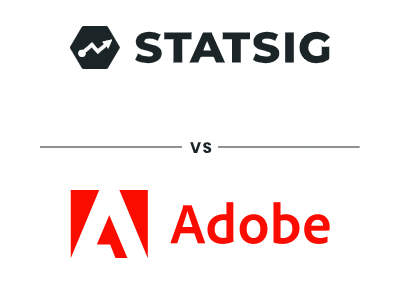Statsig and Adobe target Compared

What is Statsig?
Statsig is an experimentation, feature management, and analytics platform designed to help companies build better products. It caters to technical teams focused on building software products, providing them with a comprehensive suite of tools to ship, test, and analyze new features with confidence.
Statsig's key features include:
Feature Flags: Release automation, scheduled progressive rollouts, and advanced targeting
A/B Testing: Advanced experimentation solution trusted by companies like OpenAI, Atlassian, and Microsoft
Product Analytics: User funnels, user journeys, metric drilldowns, and more
Web Analytics: Single snippet to get analytics data flowing for your website
Session Replay: Re-watch any user session or filter down to specific sessions
By combining these tools into a single platform, Statsig enables businesses to make data-driven decisions and optimize their products for maximum impact. The platform is designed to be user-friendly and accessible to teams of all sizes, from startups to Fortune 500 companies.
TL;DR: Statsig is a tool that's well-suited for technical teams looking to build and optimize software products. It offers a comprehensive set of features for experimentation, feature management, and analytics, making it easier to make data-driven decisions.
What is Adobe Target?
Adobe Target is a solution for A/B testing, personalization, and optimization of digital experiences across various channels. It enables businesses to deliver tailored, relevant content to their customers, driving engagement, conversions, and loyalty. With AI-powered capabilities, Target allows marketers and product managers to test and optimize every aspect of the user experience.
Adobe Target caters to a wide range of users and customers, including marketers, product managers, and developers who are looking to optimize their digital properties and campaigns. The platform is designed to be user-friendly and accessible, with a streamlined interface and intuitive workflows that enable teams to collaborate effectively and efficiently.
Key features of Adobe Target include:
A/B and multivariate testing to determine the most effective variations of content, design, and functionality
AI-powered automation and scalability to personalize experiences for individual visitors
Omnichannel personalization capabilities, leveraging a unified, progressive profile for consistent experiences across touchpoints
Real-time connectivity to Adobe Experience Platform, a new user interface, and generative AI tools
TL;DR: Adobe Target is a tool that's well-suited for marketers, product managers, and developers looking to optimize digital experiences. However, it may require more technical expertise to fully leverage its advanced features.
Statsig vs Adobe Target & Analytics, head to head

Integrations comparison
Statsig offers a wide range of integrations with popular data warehouses, analytics tools, and CI/CD platforms. This flexibility allows companies to seamlessly incorporate Statsig into their existing tech stack, enabling them to leverage their data and workflows effectively. Notable integrations include Snowflake, BigQuery, Redshift, Amplitude, Mixpanel, Segment, GitHub Actions, and CircleCI.
In contrast, Adobe Target is part of the Adobe Experience Cloud suite, which includes other Adobe products such as Analytics, Campaign, and Audience Manager. While this integration provides a cohesive ecosystem for businesses already invested in the Adobe suite, it may limit flexibility for companies using other tools. Adobe Target's integrations are primarily focused on the Adobe ecosystem, which can be a drawback for organizations with diverse tech stacks.
Statsig's approach to integrations emphasizes adaptability and compatibility with a variety of tools and platforms. This allows companies to maintain their preferred tools and processes while benefiting from Statsig's feature management and experimentation capabilities. By offering a wide range of integrations, Statsig ensures that its platform can be easily adopted by teams of all sizes and across various industries.
TL;DR: Statsig and Adobe Target's integrations are both well-suited for businesses looking to optimize their digital experiences. However, Adobe Target's integrations are primarily focused on the Adobe ecosystem, while Statsig offers more flexibility in integrating with existing tech stacks.
Pricing comparison
Statsig offers usage-based pricing with generous free tiers, making it an attractive option for teams of all sizes. The company provides a Developer Tier that includes unlimited feature flags and 2 million events per month at no cost. Statsig's pricing remains transparent and empowers teams to be data-driven without seat limitations or MAU-based pricing.
In contrast, Adobe Target's pricing is tailored to enterprise customers, with flexible licensing and configuration options based on product options, volume, and omnichannel delivery. While specific pricing details are not provided on their website, interested businesses can contact Adobe's sales team to discuss how the product can help identify their best content and deliver it to the right customer at the right moment.
When comparing the two platforms, Statsig is generally more cost-effective, especially for smaller teams and startups. With its generous free tier and transparent pricing structure, Statsig allows companies to scale their experimentation and feature management efforts without breaking the bank. Additionally, Statsig offers a wide range of integrations with popular tools and platforms, making it easy for teams to incorporate the platform into their existing workflows.
TL;DR: Statsig and Adobe Target's pricing are both well-suited for businesses looking to optimize their digital experiences. However, Statsig's transparent, usage-based pricing and generous free tier make it a more accessible and cost-effective option for smaller teams and startups.
The bottom line: Key differences between Statsig and Adobe Target
Statsig and Adobe Target both offer experimentation and personalization capabilities, but they cater to different audiences and use cases. Statsig is a more technical platform, designed for developers and product teams who need advanced experimentation and analytics features. It offers a comprehensive suite of tools, including feature flags, product analytics, and session replay, all in one platform. This allows teams to easily test and iterate on new features, while gaining deep insights into user behavior.
On the other hand, Adobe Target is more marketing-oriented, focusing on delivering personalized experiences to customers across various channels. It leverages AI-powered automation to scale personalization efforts and integrates with other Adobe Experience Cloud products. While Adobe Target does offer A/B testing and optimization capabilities, it may not have the same level of technical depth and flexibility as Statsig.
Companies often choose Statsig for its advanced experimentation capabilities, ease of use, and affordability. Statsig's platform is built to handle large-scale experimentation, processing over 250 billion events per day. It also offers a generous free tier and usage-based pricing, making it accessible to teams of all sizes.
With its focus on empowering technical teams and fostering a culture of experimentation, Statsig has become the go-to choice for companies like Brex, SoundCloud, and Ancestry. Don't hesitate to reach out if you want to learn more.
Statsig vs Adobe Target & Analytics, head to head
